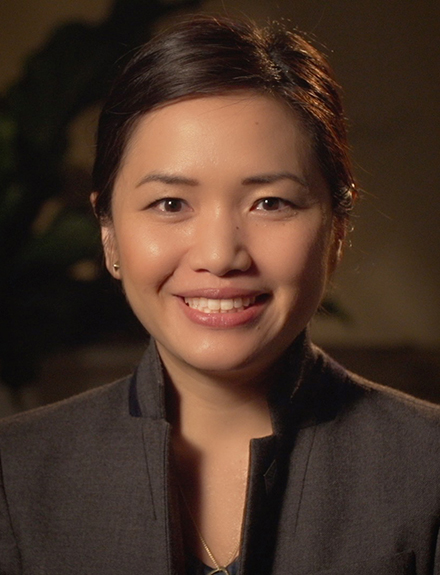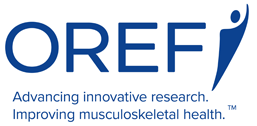

Debbie Yen-Dao Dang, MD, PhD
Resident Clinician Scientist Training Grant
Research Topic
Investigating the role of the adhesion protein cadherin 11 during fracture healing
Patient Impact
Pharmacological interventions that target cadherin 11 might be used to modulate fracture healing.
The biology of fracture healing
OREF grant recipient searchers for clues to new treatments
Jay D. Lenn, OREF contributing writer
The risk of delayed union or non-union after treatment for a bone fracture is associated with a number of factors, including the fracture site, severity of injury, age of patient, nutrition, tobacco use and diabetes. Delays or failures to heal result in more intensive medical care, a decline in quality of life and increased expenses. To improve outcomes in these difficult cases, investigators have been exploring means to identify and alter biological barriers to healing.
“Why do some people heal and some don’t? It’s unclear,” stated Debbie Yen-Dao Dang, MD, PhD, an orthopaedic surgery resident at the University of California, San Francisco, “but presumably it’s about the biology of each patient. We would benefit from understanding this biology and developing medications to promote fracture healing.”
Dr. Dang has been investigating the possible role of a transmembrane protein called cadherin 11. Her work was funded in part by a 2015 Orthopaedic Research and Education Foundation (OREF) Resident Clinician Scientist Training Grant. The one-year OREF grant awards $20,000 with the goal of preparing a resident for a career with research as a major component. Funding for the grant was made possible by the Ira A. Rochelle Family Foundation.
Dr. Dang noted, “While [such intracellular proteins] have been studied extensively in the skeletal system, there is a class of proteins that are expressed on the cell surface that have not been investigated.”
These proteins, called cadherins, play an important role in cell-to-cell adhesion. In other organ systems, cadherins have been shown to interact with intracellular signaling molecules to affect overall cellular, tissue, and organ activity.
“Given this close relationship in other systems, it is reasonable to think that cadherins play an important, yet unknown, role in skeletal processes, including fracture healing,” Dr. Dang explained.
Dr. Dang is interested specifically in cadherin 11, which is expressed relatively specifically in the skeletal system. As a transmembrane protein in bones and cartilage, it provides a kind of portal to intracellular activity. Both factors make it a good candidate for exploring pharmaceutical interventions. “A transmembrane protein is really attractive as a drug target,” stated Dr. Dang. “If we could find something with an affinity to cadherin 11 on the outside of the cell, we might affect what’s going on inside and promote processes that help with fracture healing.”
One aim was to identify the spatial and temporal expression of cadherin 11 during healing. A second aim was to compare fracture healing in genetically normal mice and mice that had the gene for cadherin 11 disabled.
Dr. Dang explained, “Comparing the two groups can answer important questions. Do these fractures look different when they’re healing? Does the fracture heal better in one group than the other? And what are the differences in the types of proteins expressed in each fracture site throughout the healing process?”
She added that OREF both builds on the rich past of orthopaedic research and promotes its development. She stated, “I see a lot of foresight, a lot of planning at OREF for investing in young clinician scientists. It’s a privilege to be supported by OREF and be a part of its investment in the future."
“Why do some people heal and some don’t? It’s unclear,” stated Debbie Yen-Dao Dang, MD, PhD, an orthopaedic surgery resident at the University of California, San Francisco, “but presumably it’s about the biology of each patient. We would benefit from understanding this biology and developing medications to promote fracture healing.”
Dr. Dang has been investigating the possible role of a transmembrane protein called cadherin 11. Her work was funded in part by a 2015 Orthopaedic Research and Education Foundation (OREF) Resident Clinician Scientist Training Grant. The one-year OREF grant awards $20,000 with the goal of preparing a resident for a career with research as a major component. Funding for the grant was made possible by the Ira A. Rochelle Family Foundation.
A tale of two proteins
Previous research with animal models of fracture healing have demonstrated the importance of intracellular signaling proteins during the recovery process. However, these molecules within a cell are difficult to assess from a pharmacological standpoint.Dr. Dang noted, “While [such intracellular proteins] have been studied extensively in the skeletal system, there is a class of proteins that are expressed on the cell surface that have not been investigated.”
These proteins, called cadherins, play an important role in cell-to-cell adhesion. In other organ systems, cadherins have been shown to interact with intracellular signaling molecules to affect overall cellular, tissue, and organ activity.
“Given this close relationship in other systems, it is reasonable to think that cadherins play an important, yet unknown, role in skeletal processes, including fracture healing,” Dr. Dang explained.
Dr. Dang is interested specifically in cadherin 11, which is expressed relatively specifically in the skeletal system. As a transmembrane protein in bones and cartilage, it provides a kind of portal to intracellular activity. Both factors make it a good candidate for exploring pharmaceutical interventions. “A transmembrane protein is really attractive as a drug target,” stated Dr. Dang. “If we could find something with an affinity to cadherin 11 on the outside of the cell, we might affect what’s going on inside and promote processes that help with fracture healing.”
Modeling fracture healing in the lab
In her OREF-funded investigation, Dr. Dang characterized fracture healing in mouse models. Each mouse under anesthesia underwent a procedure to create a tibial fracture that could be consistently replicated. Mice were monitored and treated for pain. Sets of mice were sacrificed at multiple time points to enable radiographic and molecular assessments at different stages in the healing process.One aim was to identify the spatial and temporal expression of cadherin 11 during healing. A second aim was to compare fracture healing in genetically normal mice and mice that had the gene for cadherin 11 disabled.
Dr. Dang explained, “Comparing the two groups can answer important questions. Do these fractures look different when they’re healing? Does the fracture heal better in one group than the other? And what are the differences in the types of proteins expressed in each fracture site throughout the healing process?”
Promoting the future of orthopaedics
Dr. Dang described the OREF grant as instrumental in her development as a clinician scientist. “Without the grant, I would still be interested in research, but I would not have been able to ask my own question—a novel question that others were not asking.”She added that OREF both builds on the rich past of orthopaedic research and promotes its development. She stated, “I see a lot of foresight, a lot of planning at OREF for investing in young clinician scientists. It’s a privilege to be supported by OREF and be a part of its investment in the future."
Jay D. Lenn is a contributing writer for OREF and can be reached at communications@oref.org
